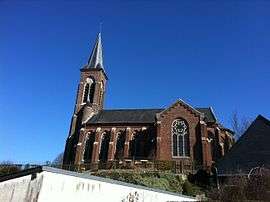Étreux
Étreux is a commune in the Aisne department in Hauts-de-France in northern France.
Étreux | |
|---|---|
 The church of Étreux | |
 Coat of arms | |
Location of Étreux 
| |
 Étreux  Étreux | |
| Coordinates: 49°59′42″N 3°39′27″E | |
| Country | France |
| Region | Hauts-de-France |
| Department | Aisne |
| Arrondissement | Vervins |
| Canton | Guise |
| Government | |
| • Mayor (2008–2014) | Joël Noisette |
| Area 1 | 10.36 km2 (4.00 sq mi) |
| Population (2017-01-01)[1] | 1,459 |
| • Density | 140/km2 (360/sq mi) |
| Time zone | UTC+01:00 (CET) |
| • Summer (DST) | UTC+02:00 (CEST) |
| INSEE/Postal code | 02298 /02510 |
| Elevation | 115–160 m (377–525 ft) (avg. 144 m or 472 ft) |
| 1 French Land Register data, which excludes lakes, ponds, glaciers > 1 km2 (0.386 sq mi or 247 acres) and river estuaries. | |
History
The first major engagement of the British Expeditionary Force (BEF) in the First World War in August 1914, resulted in what became known as the Great Retreat during the Battle of Mons, in the course of which a strategic rearguard action was called for in order to allow the BEF to escape.
Tasked with holding their ground under all circumstances, the 2nd Royal Munster Fusiliers, in their very first action in France, achieved a military feat seldom paralleled in modern warfare.[2] A brigade may occasionally have the task of trying to delay a whole enemy division. A division may perhaps be deployed in an attempt to turn aside or halt an advancing army corps – but for a single battalion to stem the advance of an entire army by their sole action was unprecedented. In fact, less than a battalion strength, just 3 companies of the 2nd. Battalion of The Munsters halted the advance of the German Army for fourteen hours in the area of Oisny & Étreux during the retreat from Mons on 27 August, thus enabling the rest of the British Army to withdraw to a safe distance of twelve miles.
In their action at Ètreux the 2nd Munsters were decimated, with only five officers and 196 other ranks surviving. Nevertheless, the Battalion's action effectively prevented German pursuit of the BEF I Corps.[3] They were outnumbered at odds of over 6 to 1, and when finally defeated, the survivors were congratulated on their supreme bravery by the German soldiers they had fought.
In 1922, a cross was erected in an orchard in Étreux, just behind the railway station, to the memory of 120 men of the Munsters's 2nd. Battalion who fell there in their last stand on 27 August 1914. The officers and men of the Regiment who died in that battle are buried there alongside the carved monumental cross dedicated to their memory. Part of the inscription reads " In proud and lasting memory of ..... the officers, warrant officers, non-commissioned officers and men of the 2nd. Battalion, Royal Munster Fusiliers ..... who laid down their lives during The Great War in the cause of Freedom and Justice, 1914–1918"
The Great War occupation by the Germans soldiers in Etreux has been recorded by Albert Denisse (1868 – 1946)
Population
| Year | Pop. | ±% |
|---|---|---|
| 1962 | 1,489 | — |
| 1968 | 1,588 | +6.6% |
| 1975 | 1,655 | +4.2% |
| 1982 | 1,839 | +11.1% |
| 1990 | 1,754 | −4.6% |
| 1999 | 1,670 | −4.8% |
| 2008 | 1,567 | −6.2% |
See also
References
- "Populations légales 2017". INSEE. Retrieved 6 January 2020.
- The Etreux Rearguard Action Archived 2009-08-19 at the Wayback Machine External link to Home Page: Royal Munster Fusiliers Association
- Bowman, Timothy: Irish Regiments in the Great War "Regular regiments at war" p.49, Manchester University Press (2003) ISBN 0-7190-6285-3
Notes to Bowman above Ch.2:
McCance, S.: The History of the Royal Munster Fusiliers, vol.II, From 1861 to 1922 p.119, Gale and Polden, Aldershot (1927)
Jervis, H.S.: The 2nd Munsters in France p.8 & p.12, Gale and Polden, Aldershot (1922)
Johnstone, T.: Orange, Green and Khaki The Story of Irish Regiments in the Great War, 1914–18 pp.27–34, Gill and Macmillan, Dublin (1992)
Staunton, M.: The Royal Munster Fusiliers in the Great War p.26, MA thesis, University College Dublin (1986)
| Wikimedia Commons has media related to Étreux. |